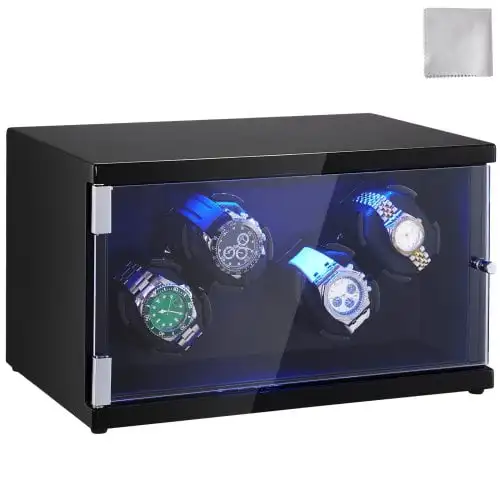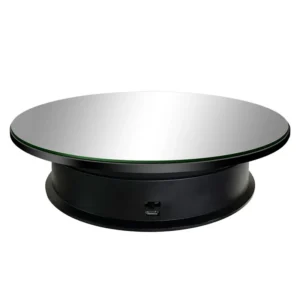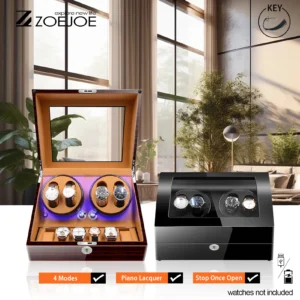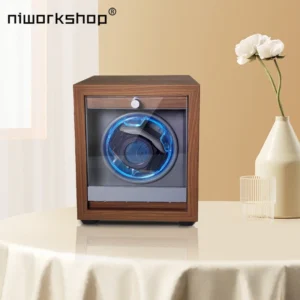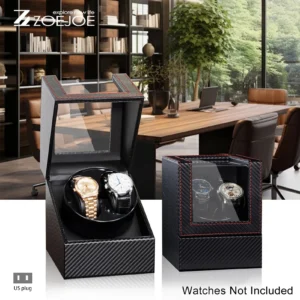Introduction
For owners of automatic watches, a watch winder serves as an essential accessory that keeps timepieces running when not being worn. These clever devices simulate the natural motion of your wrist, ensuring your automatic watch remains wound and ready for use. But how often should a watch winder actually rotate to maintain optimal performance?
The answer lies in understanding “Turns Per Day” (TPD) – the standard measurement used to quantify rotation frequency in the watch world. Most automatic watches require between 650-1200 turns per day to maintain accurate timekeeping, but the specific needs vary significantly between different watch brands and movements.
Getting the rotation frequency right isn’t just about convenience – it directly impacts your watch’s accuracy, longevity, and overall performance. Using improper settings might leave your watch without enough power or potentially cause unnecessary wear to the movement.
In this guide, we’ll explore everything you need to know about watch winder rotation frequency, including:
– What TPD means and why it matters
– How winding cycles actually work
– Finding the perfect settings for your specific timepiece
– Common myths about overwinding
Understanding proper watch collection storage planning begins with knowing how to correctly use your watch winder – let’s dive in.
Understanding Turns Per Day (TPD): The Foundation of Watch Winding
Turns Per Day (TPD) represents the total number of complete 360-degree rotations that a watch winder performs within a 24-hour period. This measurement serves as the universal standard in horology for determining how much movement an automatic watch requires to maintain optimal power reserve.
TPD is directly linked to how automatic watches function. Inside your timepiece, the rotor (a semi-circular metal weight) swings with wrist movement, winding the mainspring which stores energy to power the watch. When not worn, a watch winder recreates this motion, ensuring the mainspring maintains sufficient tension.
Different watch movements have different winding efficiency levels. Some high-efficiency movements might require as few as 650 TPD, while others need 1,200 or more. This variation stems from differences in:
- Mainspring design and capacity
- Rotor weight and efficiency
- Power reserve duration
- Overall movement architecture
Using the correct TPD setting ensures your watch receives just enough motion to stay powered without excessive rotation. Too few rotations might leave your watch without adequate power reserve, while excessive TPD doesn’t necessarily damage modern watches but represents unnecessary wear and energy consumption.
The relationship between TPD and watch accuracy is straightforward – a properly wound mainspring delivers consistent power to the escapement, resulting in stable timekeeping. Insufficient winding can lead to power fluctuations that affect accuracy.
Understanding how watch winder rotation cycles work is essential for selecting the right settings for your timepiece. If you’re looking to purchase a new winder, exploring various watch winders will help you find one with appropriate TPD settings for your collection.
How Watch Winding Cycles Actually Work
Contrary to what many people assume, watch winders don’t rotate continuously throughout the day. Instead, they operate using intermittent winding cycles—alternating between periods of rotation and rest. This pattern more accurately mimics the natural movement patterns of a watch worn on the wrist.
A typical winding cycle might look like this:
– 30-60 seconds of rotation
– 2-3 minutes of rest
– Repeat cycle
These intermittent cycles distribute the total TPD (Turns Per Day) across the entire day, preventing unnecessary strain on the watch’s winding mechanism. For example, a watch needing 800 TPD might receive its rotations through approximately 35-40 short rotation periods spread over 24 hours.
This intermittent approach offers several benefits:
– Prevents excessive heat build-up in the winder motor
– Reduces wear on both the winder mechanism and watch components
– More closely simulates natural wrist movement patterns
– Conserves power (for battery-operated winders)
Quality watch winders typically use quiet, efficient motors with timing circuits that carefully control these rotation and rest periods. Some advanced models even vary the rotation speed or pattern to better simulate human movement.
Understanding these watch winder TPD settings helps you make better use of your device. If you’re in the market for a new winder, many automatic watch winders allow you to customize these cycle patterns to match your specific timepiece’s requirements.
Rotation Direction Matters: Clockwise, Counter-Clockwise, or Both?
When setting up your watch winder, rotation direction is just as important as TPD settings. Watch winders typically offer three directional settings:
Clockwise (CW) Rotation
– Used for watches that wind exclusively in the clockwise direction
– Common in older watch movements and some specialized designs
– Usually indicated by manufacturers with “CW” or similar notation
Counter-Clockwise (CCW) Rotation
– Required for watches that wind only in the counter-clockwise direction
– Less common but still found in certain watch movements
– Typically marked as “CCW” in manufacturer specifications
Bidirectional Rotation
– Alternates between clockwise and counter-clockwise movements
– Ideal for modern watches with bidirectional winding systems
– Most versatile setting, compatible with the majority of contemporary automatic watches
The direction requirement is determined by the design of your watch’s rotor system. Some rotors are engineered to capture energy from motion in only one direction, while others (particularly modern designs) utilize movement in both directions to maximize winding efficiency.
Most contemporary automatic watches use bidirectional winding mechanisms, making them compatible with bidirectional winder settings. However, certain prestigious manufacturers maintain specific directional requirements based on their movement design philosophy.
Using the incorrect rotation direction can result in inadequate winding, even if your TPD setting is correct. Your watch might appear to be on a winder but won’t maintain proper power reserve because the rotations aren’t engaging the winding mechanism effectively.
When organizing your watch collection, grouping timepieces by their winding direction requirements can help simplify maintenance and ensure all pieces receive appropriate care.
The Myth of Overwinding: What Really Happens
One of the most persistent concerns among automatic watch owners is the fear of overwinding their timepieces using a watch winder. However, this worry is largely unfounded for modern automatic watches.
Myth: Continuous use of a watch winder will overwind and damage an automatic watch.
Reality: Nearly all modern automatic watches contain a slip-clutch mechanism (also called a bridle or mainspring brake) that physically prevents overwinding.
Here’s how it actually works:
– As the mainspring reaches full tension, the slip-clutch system engages
– This mechanism allows the winding rotor to continue turning without adding more tension to the mainspring
– The system effectively “disengages” the winding mechanism once maximum power reserve is reached
– This built-in protection prevents damage from excessive winding
This ingenious safety feature means that even if your watch winder runs continuously with TPD settings higher than recommended, the watch’s internal mechanisms prevent harmful overwinding.
However, using the correct TPD settings still matters for several reasons:
– Unnecessary winding cycles create wear on the clutch mechanism itself
– Higher settings waste electricity (for plug-in models) or battery life (for battery-operated winders)
– Excessive motion can potentially cause other wear issues over time
For optimal care of your timepiece, matching your winder settings to your watch’s specific requirements remains the best practice, even with overwinding protection in place.
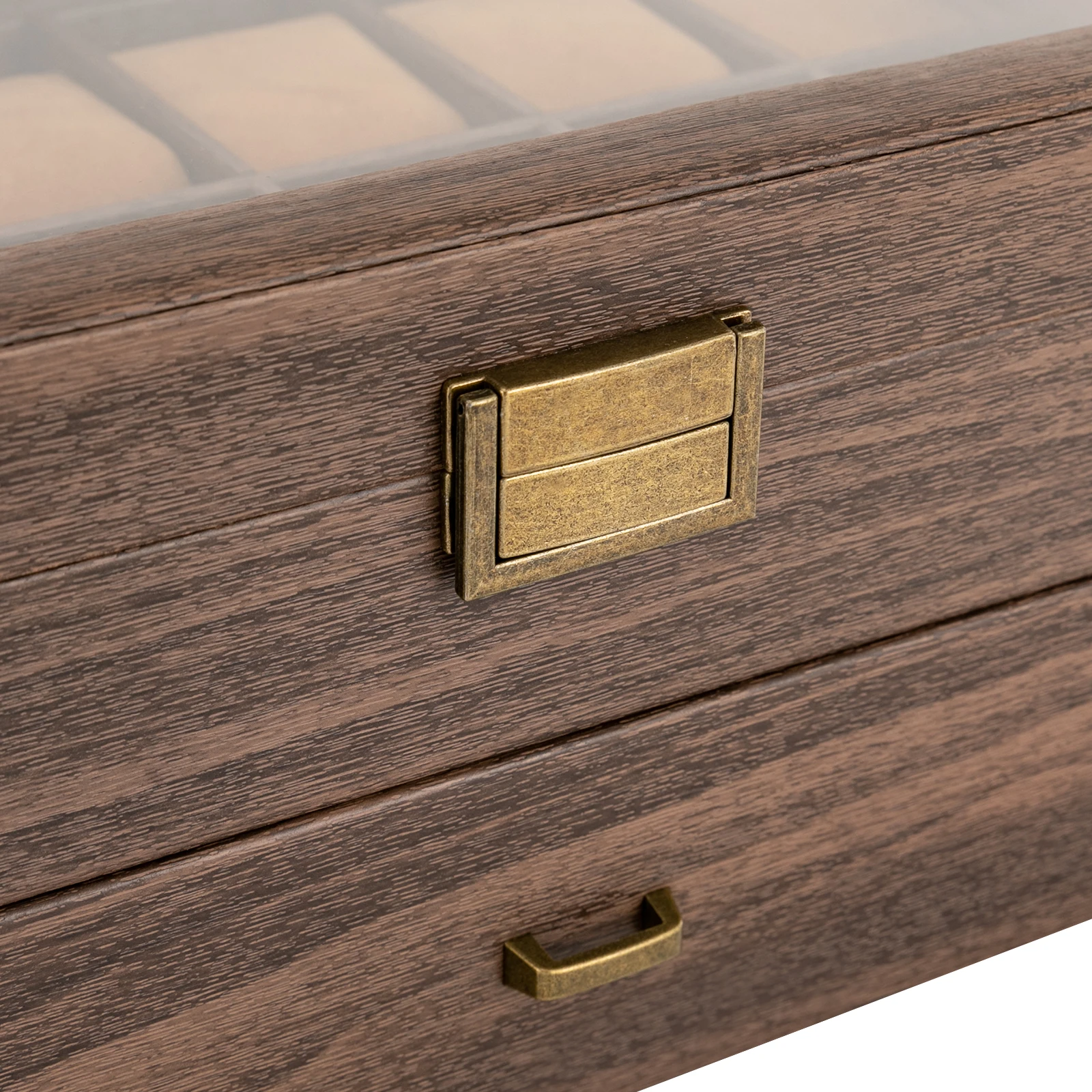
For those with valuable timepieces, investing in luxury watch winders with precise TPD controls can provide peace of mind and ensure proper maintenance of your collection.
Finding the Right TPD Setting for Your Specific Watch
Determining the correct TPD setting for your automatic watch involves a straightforward process:
Check the watch manual – The manufacturer’s documentation often lists recommended TPD settings and rotation direction.
Visit the manufacturer’s website – Many luxury watch brands provide care instructions, including winder specifications, on their official websites.
Consult online TPD databases – Several watch enthusiast websites maintain comprehensive databases of TPD requirements for popular watch models and movements.
Identify your movement – If you know which movement powers your watch (like ETA 2824 or Sellita SW200), you can look up specific requirements for that caliber.
Contact the manufacturer – For rare or specialized timepieces, reaching out directly to the manufacturer’s customer service can provide the most accurate information.
If you can’t determine the exact TPD requirement, a safe approach is to:
– Start with a conservative setting (around 650-800 TPD)
– Set rotation to bidirectional if uncertain about direction
– Monitor your watch’s timekeeping over several days
– Adjust settings if the watch loses time (increase TPD) or if other issues arise
Remember that when in doubt, it’s better to use a slightly lower TPD setting than an excessive one. Most automatic watches will maintain accuracy with minimal winding, and you can always manually wind the watch occasionally to supplement.
For collectors with diverse timepieces, implementing effective watch storage ideas for collectors can help maintain organization while ensuring each piece receives proper care. If you’re looking for equipment, exploring rotating watch holders can provide options with appropriate settings for various watch types.
TPD Ranges for Popular Watch Brands and Movements
Different watch brands and movements have specific TPD requirements to maintain optimal performance. Here’s a reference table of common brands and their general TPD recommendations:
| Brand/Movement | TPD Range | Rotation Direction |
|---|---|---|
| Rolex | 650-800 | Bidirectional |
| Omega | 650-800 | Bidirectional |
| Tag Heuer | 800-1000 | Bidirectional |
| Seiko | 650-850 | Bidirectional |
| Breitling | 650-800 | Bidirectional |
| Patek Philippe | 800-1000 | Bidirectional |
| Audemars Piguet | 800-1000 | Bidirectional |
| IWC | 750-850 | Clockwise |
| ETA 2824-2 | 650-800 | Bidirectional |
| Sellita SW200 | 650-800 | Bidirectional |
| Miyota 9015 | 650-850 | Bidirectional |
Important notes regarding this information:
– These are general guidelines – specific models within each brand may have different requirements
– Watches with complications (chronographs, moon phases, etc.) may require higher TPD settings
– Vintage watches often have different requirements than modern models from the same brand
– When in doubt, consult model-specific documentation
This table provides starting points for common watches, but understanding when to use and not use watch winders can help you make appropriate decisions for your specific timepieces.
How to Test if Your Watch Winder Settings Are Correct
Verifying whether your watch winder settings are appropriate requires a systematic approach:
Set your watch to the exact time using an accurate reference (like time.gov or your smartphone).
Fully wind your watch manually to ensure it starts with a complete power reserve.
Place the watch on the winder with your selected TPD and direction settings.
Leave it for 48-72 hours without handling the watch.
Check the accuracy by comparing to your reference time source.
Based on your results, adjust as needed:
– If the watch loses time: Your TPD setting may be too low. Increase by 100-200 TPD and test again.
– If the watch stops: The TPD setting is definitely insufficient or the direction setting may be incorrect.
– If the watch maintains good time: Your settings are appropriate.
– If the watch runs fast: This typically isn’t related to winder settings but might indicate the watch needs servicing.
Signs that your watch isn’t receiving enough rotation:
– Power reserve depletes faster than expected
– Timekeeping becomes inconsistent
– The watch stops completely within its expected power reserve period
For fine-tuning, make small adjustments (increasing or decreasing by 100-200 TPD) and test again until you find the optimal setting for your specific timepiece.
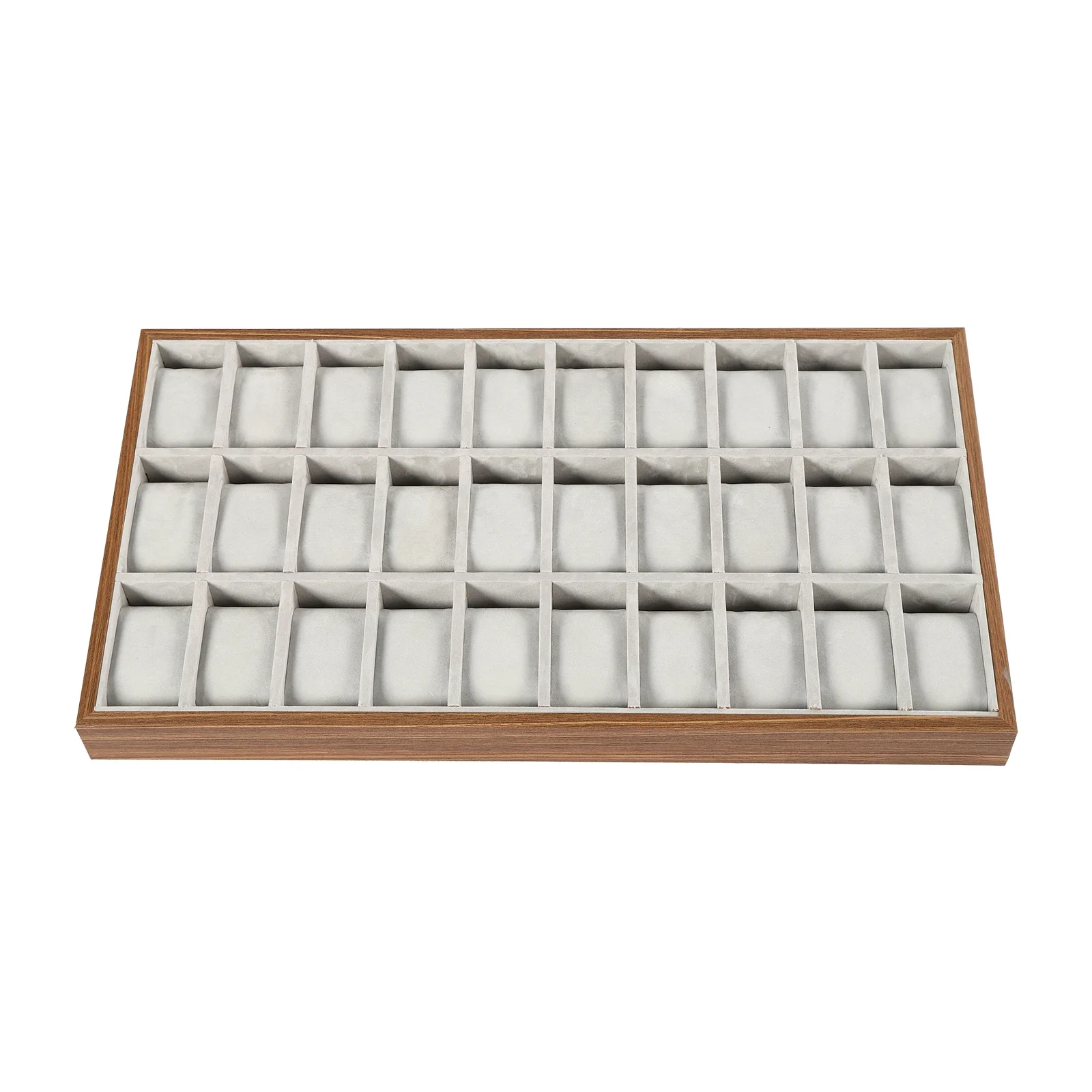
For those with individual timepieces, a single watch winder with adjustable settings makes this testing process more straightforward.
Daily Operation: How Long Should a Watch Winder Run?
A common misconception is that watch winders need to operate continuously 24/7. In reality, most automatic watches don’t require constant winding to maintain accuracy and performance.
Typical Operation Guidelines:
– 8-12 hours of active winding cycles per day is usually sufficient for most watches
– The winder can be off for the remaining hours without affecting watch performance
– Many quality winders include programmable timers to automate this schedule
Your ideal operation schedule depends on your wearing habits:
– Daily wear rotation: If you rotate between several watches throughout the week, running the winder for 8 hours daily while you sleep keeps watches ready
– Occasional wear: For watches worn once every 1-2 weeks, running the winder for 8-12 hours every 2-3 days is typically adequate
– Long-term storage: For watches kept in reserve for special occasions, a once-weekly winding session of 12 hours helps maintain lubrication
Using timers or smart plugs to automate your winder’s operation schedule can help conserve power while ensuring watches remain ready for use. Many higher-end winders include built-in programming features to set specific active periods.
This approach not only conserves electricity but also extends the operational life of your watch winder’s motor. When comparing types of watch storage, consider winders with programmable timers if you plan to use them for long-term maintenance.
Benefits of Proper Watch Winding Beyond Convenience
While keeping your watch ready to wear is the most obvious benefit of a watch winder, proper winding offers several additional advantages for your timepiece:
Maintains Mechanical Health
Consistent motion helps distribute lubricants throughout the movement, preventing oils from congealing or drying out. This reduces friction and wear on critical components like jewel bearings and gear trains.
Preserves Timekeeping Accuracy
Watches running continuously tend to maintain more consistent rates than those that repeatedly stop and start. This steadier operation often results in better overall timekeeping performance.
Extends Service Intervals
By keeping lubricants properly distributed and components engaged, regular winding can potentially extend the time between required service appointments.
Protects Complications
Watches with date displays, moon phases, or perpetual calendars benefit particularly from continuous operation, as it prevents the need for resetting these complex functions after power depletion.
Reduces Setting Wear
Frequent winding and setting of a watch that’s stopped can create wear on crown components and setting mechanisms. A properly wound watch minimizes this type of manipulation.
For collections with multiple timepieces, a 4-watch winder allows you to maintain several pieces simultaneously while enjoying these preservation benefits.
Automatic Watch Winder, Luxury Watch Winder, Single Watch Box
$307.39 Select options This product has multiple variants. The options may be chosen on the product pageRotating Watch Holder, Watch Holder
Price range: $93.28 through $93.35 Select options This product has multiple variants. The options may be chosen on the product page4 Watch Winder, 6 Watch Box, Automatic Watch Winder
$512.31 Select options This product has multiple variants. The options may be chosen on the product pageAutomatic Watch Winder, Single Watch Winder, Wooden Watch Holder
$201.76 Select options This product has multiple variants. The options may be chosen on the product pageAutomatic Watch Winder, Leather Watch Travel Case, Single Watch Winder
$146.30 Select options This product has multiple variants. The options may be chosen on the product pageAutomatic Watch Winder, Double Watch Winder, Leather Watch Boxes
$147.60 Select options This product has multiple variants. The options may be chosen on the product page
When Not to Use a Watch Winder: Special Considerations
While watch winders offer many benefits, there are specific situations where using one might not be ideal:
Vintage Watches Without Slip-Clutch Mechanisms
Older watches (generally pre-1960s) may lack overwinding protection. These timepieces should be wound carefully by hand rather than placed on continuous winders.
Watches with Extended Power Reserves
Modern watches with 3-7 day power reserves (like many by Panerai or IWC) may not need winder assistance unless they’re worn very infrequently.
Collector’s Pieces Rarely Worn
For watches kept primarily as collectibles and seldom worn, occasional manual winding (once every 1-2 months) may be preferable to continuous winding.
During Service Intervals
Prior to sending a watch for service, allowing it to wind down naturally can help the watchmaker assess power reserve performance.
Preference for Manual Winding
Some enthusiasts prefer the ritual of manually winding their watches, enjoying the connection to the mechanical nature of their timepieces.
If you store watches for extended periods without wearing them, consider whether they should be fully wound or allowed to stop. For long-term storage (months or years), many experts recommend allowing the movement to stop completely rather than maintaining tension on the mainspring.

Frequently Asked Questions About Watch Winder Rotation
Q: Will using too high a TPD setting damage my watch?
A: Modern automatic watches have slip-clutch mechanisms that prevent overwinding damage. However, using unnecessarily high TPD settings creates additional wear on this clutch mechanism and wastes energy.
Q: How quiet should a watch winder be during rotation cycles?
A: Quality watch winders operate at around 5-15 decibels – barely audible in a quiet room. Excessive noise during rotation might indicate motor issues or improper construction.
Q: How does TPD setting affect battery life in portable watch winders?
A: Higher TPD settings require more frequent motor operation, which can reduce battery life by 30-50% compared to lower settings. For battery-operated winders, using the minimum effective TPD is recommended.
Q: What if I have multiple watches with different TPD requirements?
A: Multi-watch winders with individually programmable settings are ideal. Alternatively, group watches with similar requirements together, using the highest common TPD setting that’s still within range for all watches.
Q: Do climate conditions affect ideal TPD settings?
A: While TPD requirements don’t change significantly with climate, watches in very cold environments may benefit from slightly higher TPD settings as lubricants become more viscous at lower temperatures.
Q: Should TPD settings be adjusted for watches worn infrequently versus daily?
A: Watches worn infrequently can often use lower TPD settings or intermittent winder use (every few days) rather than continuous operation, which helps minimize unnecessary wear.
By understanding these key aspects of watch winder operation, you can ensure your automatic timepieces receive the perfect amount of motion to keep them performing at their best while extending their service life.

